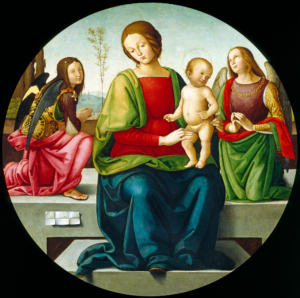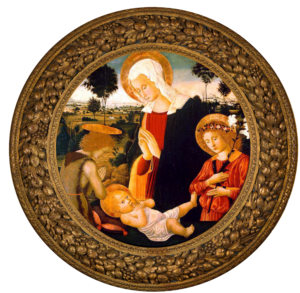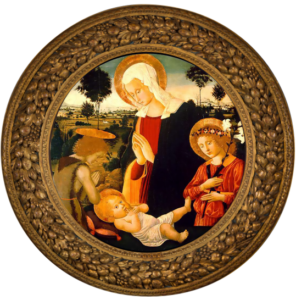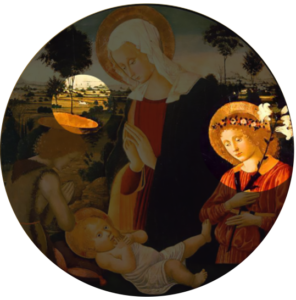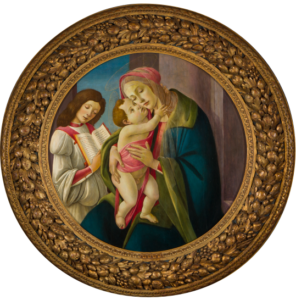Madonna and Child with Angels
Tempera and oil on panel
Master of the Greenville Tondo
Umbrian, active late 15th century
This mystery painting was once attributed to the young Umbrian, Raphael as possibly one of his early works (Giuseppe Fiocco, 1937), which could “aid in the studies of the formation of Raphael’s personality” (Mario Salmi). Then, it was suggested as characteristic of Raphael’s teacher in Umbria, Pietro Vannucci, called Perugino (William Suida, 1941 and Wilhelm von Bode, 1921). But it was the great historian Federico Zeri in 1959 and later followed by Everett Fahy, former Metropolitan Museum of Art curator and Director of the Frick, who suggested a different old master entirely.
This tondo (Italian for “round”) is puzzling, but understanding the cultural context of patronage, traditional artistic training, and the workshop setting can help explain some of the mystery.
In the Middle Ages through the early Renaissance, workshop practice was the only common form of artistic instruction in Italy beginning with the religious orders, monasteries, and convents. The Trades (sculptor, mason, architect) were taught from father to son or from an older family member to a younger. Formal apprenticeships emerged in the 13th century in the context of the craft guild system when workshop or bound apprenticeship became a fully regulated system for lay artists. Then, during the 15th century, the dislike for the guild system’s restrictions and process led to an adapted concept of artistic training, called the Academy. The specific training process for artists is further developed in the article about M&G’s painting, A Sibyl by female Old Master, Ginevra Cantofoli.
Throughout all of these training methods to become a master of one’s own workshop, imitation was the most important component of artistic training. Master painters employed a workshop of assistants to copy or paint in his style and to help meet the incoming demand of commissions by patrons. These points are critical to understanding why it is difficult to attribute a specific artistic personality to today’s enduring Old Master paintings. Besides, most painters well into the late 1400s and early 1500s did not autograph their finished works, and finding the original documents commissioning paintings can be challenging.
However, when the artist is unknown, yet there is an entire group of works that look to be by the same master’s hand, the experts (as in this case) will suggest a pseudonym—create a name for the artist after the place or location where his best or most representative work resides. Zeri and Fahy chose M&G’s painting as the namesake for the painter, “The Master of the Greenville Tondo,” meaning this tondo in Greenville, SC.
According to historian Carrie Baker, this painter, subject, and style reflect the “prevailing visual tastes of the period.” Workshop practice utilized multiple assistants and collaborative work to fill commissions that looked like the master’s hand. The assistants were all skilled artisans but working for the key master. Not knowing the assistants’ names isn’t an issue as this was their occupation: to reproduce works at the request of clients in the consistent style of the master to meet customer expectations. Today, we can photograph and print our favorite originals, but then artists could only copy and repeat. Works like M&G’s Madonna and Child with Angels reflect a popular subject and shape of the period, and providing paintings like M&G’s at a client’s request was the master’s way of “positioning . . . his workshop at an economic advantage.”
Many of the masters and their assistants were truly “Renaissance” men—able to tackle the design of many things, not just paintings but manuscripts, reliquary, sculpture, fabrics, architectural features, etc. The anonymous artist as Baker notes, “was probably an active participant of a working-class system of many trades.” The artist is unknown, but by comparing similar characteristics, experts have connected at least 32 works as having come from this same artist’s hand found in places including Pancole, Italy, the Museum of Fine Arts, St. Petersburg in Florida, Princeton University Art Museum in New Jersey, the Walters Art Museum in Baltimore, and the Estensi Gallery in Modena, Italy.
Regardless of this painting and many others not being attributed to a specific, known personality—such as a respected influencer like Perugino or a major name of the Renaissance like Raphael, this master’s work was just as valuable in shaping Umbria’s artistic identity. And, more than that, our painting is shaping the estimation of our own community through the designation “Master of the Greenville Tondo”—bringing honor and recognition to the city of Greenville throughout the world where other works by this unknown master are displayed.
Erin R. Jones, Executive Director
Published 2025
